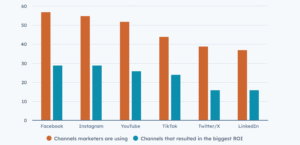How the Insidious Proliferation of Modern Marketing is Manipulating Consumers
Modern marketing methods have proliferated in insidious ways, optimized to covertly influence consumer behaviors. As advertising becomes more data-driven and personalized, it risks manipulating audiences without their full awareness or consent.
This article will explore the insidious proliferation of modern marketing, the tactics driving this, the privacy and ethical concerns they raise, and how consumers can protect themselves from invisible influences.
So What is the Insidious Proliferation of Modern Marketing?
“Insidious proliferation” refers to the covert or undetected spread or growth of something potentially harmful or unwelcome.
Broken down:
Insidious – Done in a subtle, stealthy way that is not easily noticed or understood. Often with harmful or unethical intentions that are not openly acknowledged.
Proliferation – The act or process of growing or spreading rapidly in number, amount, or extent.
Together, “insidious proliferation” describes a process of something growing or spreading widely in a subtle, unseen manner that could enable harm if not checked.
How the insidious proliferation of modern digital marketing works
The global digital advertising spend is projected to reach $526 billion by the end of 2024. This exponential growth underscores how pervasive digital marketing has become, infiltrating nearly every aspect of online interaction (WordStream).
These digital marketing tactics are done smoothly without consumers consent by:
Behavioral Tracking
As consumers browse online, every click and scroll is monitored, with trackers deployed across most major websites and apps.
This vast data collection allows advertisers to build detailed profiles on individuals, encompassing everything from health conditions and political views to product research and purchase histories.
Over time, this invisible shadow profile proliferates without users’ informed consent.
Micro-Targeting
Marketers can now send hyper-relevant ads to audiences segmented down to zip codes or medical ailments.
Coupled with demographic and lifestyle data, ads follow people based on personal attributes and behaviors.
This level of personalized targeting has proliferated rapidly, with many unaware of how granular insights harvested from their digital lives inform invisible marketing influences.
Influencer Marketing
Brands identify and partner with popular social media figures in targeted communities to spread sponsored content seamlessly amongst trusted followers.
Often this occurs without clear disclosure, proliferating surreptitious endorsements.
Consumers may unknowingly have purchasing decisions impacted by influencers promoting products within their authentic-seeming online circles.
Embedded Advertising
Ads mimic the style and placement of organic articles and videos, proliferating branded messages on platforms through subtle infiltration. As lines between paid promotions and unbiased information blur without distinguishable demarcation, some argue this enables propaganda-like manipulation at broad scales.
Social Listening
Companies analyze public social networks to find discussions of interests and opinions, then send targeted ads to individuals based on mined personal insights. This proliferates invisible uses of public digital conversations for commercial profiling without user awareness.
Dark Patterns
Websites and apps are designed through nudges and restrictions proven to guide behaviors towards desired corporate outcomes over user priorities. Relying on learned human biases, these proliferate unconscious altered decision-making at massive yet undetectable scales online.
Bots and Fakes
Inauthentic and automated accounts spread sponsored content incessantly, amplifying branded messages through fake engagement. This proliferation of marketing speech pollutes platforms and conversations through concealed inorganic influence operations.
Data Brokers
Sensitive consumer dossiers are traded in vast invisible markets, linking public and purchase profiles to personal details on health, family and more. This proliferates uses of data for targeting beyond original consent contexts, often without consumers knowing who holds their tracked identities and insights.
Together these modern tactics have unobtrusively spread commercial surveillance and manipulative marketing tactics to infiltrate nearly every online interaction, prompting concerns their influences may proliferate unnoticed in insidiously damaging societal ways without sufficient constraints or transparency.
Top Social Media Channels for Digital Marketing as of 2024

The above chart illustrates how digital marketers heavily leverage platforms like Facebook, Instagram, YouTube, TikTok, Twitter/X, and LinkedIn which are mostly used by everyone on a daily basis.
Tips for Controlling Personal Data and Resisting Manipulative Marketing Tactics
Here are some things consumers can do to take more control of their personal data and resist potentially manipulative marketing tactics:
- Opt-out of data collection and targeting whenever possible. Use privacy settings and cookies controls to limit tracking.
- Be mindful of what personal details you share online and don’t overshare on social media. Review privacy policies closely.
- Question personalized ads and notice emotional triggers used to influence purchasing. Don’t fall for subtle nudges towards over-consumption.
- Install ad/tracker-blocking browser extensions to filter out unwanted behavioral ads and data collectors.
- Use a virtual private network (VPN) to mask online activities and locations from data brokers.
- Choose services committed to privacy like those funded by subscriptions, not behavioral ads.
- Educate yourself on marketing techniques like native advertising disguised as organic content.
- Support regulation that increases transparency around data collection and targeting practices.
- Stay involved in the policy debate around protecting individual sovereignty online.
- Discuss emerging issues with friends/family and spread awareness of options for protecting privacy.
- Consider limiting children’s unsupervised access online until they can recognize marketing influences.
Taking an active role in managing personal data and remaining cognizant of marketing tactics helps consumers resist manipulation and regain more control in the digital information age. Ongoing vigilance is key as techniques continue evolving rapidly.
Final Lines
As the insidious proliferation of modern marketing infiltrates our lives, maintaining autonomy demands transparency into how our data fuels invisible influences. Both regulators and industry must find a better balance between innovative targeting and respect for individual agencies.
Consumers also shoulder the responsibility to critically assess the invisible hands that may be nudging our decisions and discussions without our full awareness or consent.
With improved transparency and consumer education around emerging techniques, perhaps relationships of trust can form that support innovation while protecting the privacy and free choice central to democratic societies.
However meaningful change requires vigilance and collaboration from all parties to establish responsible and ethical standards for an increasingly algorithmic age.

